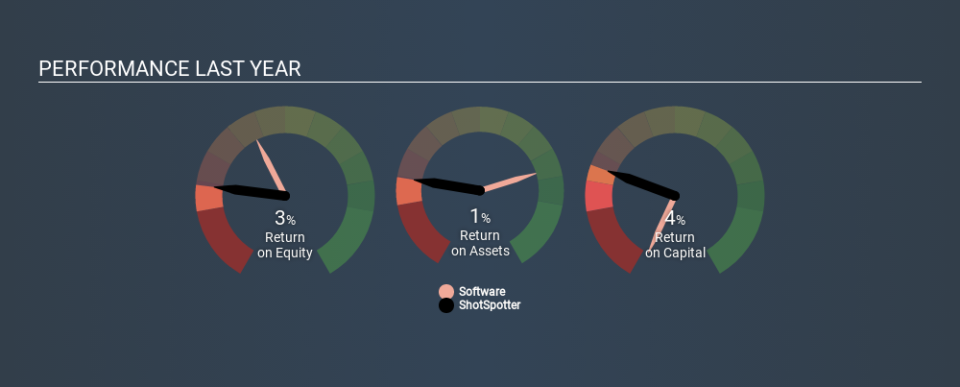How Do ShotSpotter, Inc.’s (NASDAQ:SSTI) Returns Compare To Its Industry?

Today we'll evaluate ShotSpotter, Inc. (NASDAQ:SSTI) to determine whether it could have potential as an investment idea. In particular, we'll consider its Return On Capital Employed (ROCE), as that can give us insight into how profitably the company is able to employ capital in its business.
Firstly, we'll go over how we calculate ROCE. Then we'll compare its ROCE to similar companies. Then we'll determine how its current liabilities are affecting its ROCE.
Return On Capital Employed (ROCE): What is it?
ROCE measures the amount of pre-tax profits a company can generate from the capital employed in its business. In general, businesses with a higher ROCE are usually better quality. Overall, it is a valuable metric that has its flaws. Author Edwin Whiting says to be careful when comparing the ROCE of different businesses, since 'No two businesses are exactly alike.
How Do You Calculate Return On Capital Employed?
Analysts use this formula to calculate return on capital employed:
Return on Capital Employed = Earnings Before Interest and Tax (EBIT) ÷ (Total Assets - Current Liabilities)
Or for ShotSpotter:
0.036 = US$1.1m ÷ (US$55m - US$26m) (Based on the trailing twelve months to September 2019.)
Therefore, ShotSpotter has an ROCE of 3.6%.
Check out our latest analysis for ShotSpotter
Does ShotSpotter Have A Good ROCE?
When making comparisons between similar businesses, investors may find ROCE useful. We can see ShotSpotter's ROCE is meaningfully below the Software industry average of 9.8%. This performance could be negative if sustained, as it suggests the business may underperform its industry. Independently of how ShotSpotter compares to its industry, its ROCE in absolute terms is low; especially compared to the ~1.7% available in government bonds. Readers may wish to look for more rewarding investments.
ShotSpotter delivered an ROCE of 3.6%, which is better than 3 years ago, as was making losses back then. That implies the business has been improving. You can click on the image below to see (in greater detail) how ShotSpotter's past growth compares to other companies.
It is important to remember that ROCE shows past performance, and is not necessarily predictive. Companies in cyclical industries can be difficult to understand using ROCE, as returns typically look high during boom times, and low during busts. ROCE is, after all, simply a snap shot of a single year. Since the future is so important for investors, you should check out our free report on analyst forecasts for ShotSpotter.
What Are Current Liabilities, And How Do They Affect ShotSpotter's ROCE?
Short term (or current) liabilities, are things like supplier invoices, overdrafts, or tax bills that need to be paid within 12 months. The ROCE equation subtracts current liabilities from capital employed, so a company with a lot of current liabilities appears to have less capital employed, and a higher ROCE than otherwise. To check the impact of this, we calculate if a company has high current liabilities relative to its total assets.
ShotSpotter has total assets of US$55m and current liabilities of US$26m. As a result, its current liabilities are equal to approximately 47% of its total assets. ShotSpotter has a medium level of current liabilities (boosting the ROCE somewhat), and a low ROCE.
Our Take On ShotSpotter's ROCE
There are likely better investments out there. But note: make sure you look for a great company, not just the first idea you come across. So take a peek at this free list of interesting companies with strong recent earnings growth (and a P/E ratio below 20).
If you are like me, then you will not want to miss this free list of growing companies that insiders are buying.
If you spot an error that warrants correction, please contact the editor at editorial-team@simplywallst.com. This article by Simply Wall St is general in nature. It does not constitute a recommendation to buy or sell any stock, and does not take account of your objectives, or your financial situation. Simply Wall St has no position in the stocks mentioned.
We aim to bring you long-term focused research analysis driven by fundamental data. Note that our analysis may not factor in the latest price-sensitive company announcements or qualitative material. Thank you for reading.

 Yahoo Movies
Yahoo Movies 

